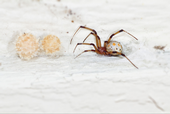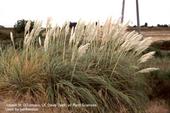![Wild blackberries growing along a roadway and encroaching into the home landscape. [Credit: Scott Oneto]](https://ucanr.edu/blogs/UCIPMurbanpests/blogfiles/95850small.jpg)
Ripe, juicy, sweet blackberries: what's not to love? Blackberries are grown for us to eat and enjoy, but some species can be considered weeds when they take over home landscapes, roadsides and waterways, and other areas. The most problematic species are the introduced wild blackberries, cutleaf blackberry and Himalayan blackberry. Blackberries can be highly competitive, smothering existing plants with their dense stands. Accumulation of dead stems can create a dangerous fire hazard.
In urban landscapes, blackberry brambles can create habitat and food for wildlife and birds, but also for rats and other pests. When invasive wild blackberries take over a...
- Author: Karey Windbiel-Rojas
- Posted by: Lauren Fordyce

The invasive pest spotlight focuses on emerging or potential invasive pests in California. In this issue, we cover the brown widow spider.
Brown Widow Spider Facts
The brown widow spider became established in Southern California in 2000 and appears to be displacing the black widow in some of its habitats, especially in urban areas. They build their webs in secluded areas around homes and in vegetation. Mature female brown widows are smaller than mature female western black widows. The normal brown widow spider coloration is a mottled mixture of tan, brown, and gray. It has a lengthwise stripe halfway up the back side of the abdomen with two isolated dots in front of it and diagonal stripes on...
- Author: Karey Windbiel-Rojas
![Features of brown marmorated stink bugs. [Credit: Steve Jacobs, PSU]](https://ucanr.edu/blogs/UCIPMurbanpests/blogfiles/95074small.jpg)
![Leaves of a river red gum eucalyptus tree covered with redgum lerp psyllids. The white growths are the “lerp” produced by the immature (nymph) stage of the insect. [Credit: Jack Kelly Clark]](https://ucanr.edu/blogs/UCIPMurbanpests/blogfiles/92910small.jpg)
If you have eucalyptus trees, you might have noticed white, crusty growth on the leaves. Or maybe you saw a sticky, blackened mess of fallen leaves under a eucalyptus tree. These are signs of the redgum lerp psyllid, one of the most common psyllid pests that damages eucalyptus trees in California.
The adult psyllid is very small and as nymphs, they are concealed under a waxy cap, or lerp. As they feed, they excrete honeydew which can lead to the growth of black sooty mold, the source of those sticky leaves under the tree.
Although under biological control in coastal areas, this pest is still a problem under some growing conditions and on specific Eucalyptus species. Cultural practices to manage...
- Author: Belinda J. Messenger-Sikes
- Editor: Karey Windbiel-Rojas

Pampasgrass and jubatagrass facts
Pampasgrass (Cortaderia selloana) is a common ornamental landscape plant that readily naturalizes throughout California's coastal areas and some interior...


